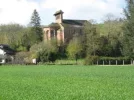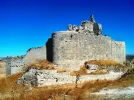As fun as speculation is, here is something from one who has studied the area. Of course, we can speculate further on motivations, etc. I think it might have been an alien culture from a flying saucer that selected the pilgrimage route.
Mid-twentieth century, was held in the province of Burgos Archaeological various tastings, to know that people lived in prehistoric ages.
Deposits were found corresponding to the initiation of the use of metals, called Calcolithic period, which ran from the 3rd millennium AD, in the Ribera del Duero, in Moradillo of Roa and Roa (Roa Lands), with pottery (bowls, cups globular, profiling and smooth S) Useful lithics (arrowheads) and bone (punches) and chapitas of pure copper and is now in the period Calcolithic Burgal bell.
• THE CIVILIZATION OF Ciempozuelos bell, and called for the deposit of madrileño Ciempozuelos, dating between the end of the 3rd millennium and the beginning of 2020 a. de C. C. It is characterized by the type of profile flared vases, decorated with a tip, arranged in narrow horizontal bands, alternating with smooth surfaces. A civilization is among the years 2200-2000and fall in the province of Burgos three sites: Atapuerca, Cerro de Burgos and the castle hill castle Castrojeriz it immersed in a room in a pocket easily and distinctly Celtic defense, as found in the high Peña Amaya, but it may also inhabit the caves of his hill, and he would use a prehistoric caves Castrojeriz, eg on the slopes of El Picacho, in the vicinity of Santo Domingo de Silos.
• In the Bronze Age I-neck (the neck of the Castro Avila), Phase I, dated 1500 to 1200 ceramics are decorated with themes points (ears, zig-zag). In a second stage, late Bronze Age, 1200 to 750 ceramics are more complex. Steppe was found in the late twentieth century, an interesting site for the culture of Phase I. In Castrojeriz, on the hill of the castle as a place defensive, found a site I nape of the period, full, between 1500 and 1200 a. de C. C.
• IN THE AGE OF IRON, Phase-750-300 a. de C. C. and second phases of the year 300 the romanization. This is called Phase 2 Christomonism. Corresponding to this time inspections have been carried out in passing in archaeological Castrojeriz, Burgos Roa.. The settlements of these villages, were taking advantage of other locations, due to his defensive position, for example. Among the known clusters include: Castrojeriz, olmillos and area of Sasamón Fernamental of Melgar. Their houses were rectangular, mud and branches as a roof and its pottery, which alone is known, has decorated quay.
• EPOCA Christomonism II Iron Age IV century a. de C. C. Become widespread tools of iron plowshares, lathes, pottery, molinos, etc. The pottery is decorated with concentric half circles, wavy lines and lozenges. The residents of this area were Vacceo Turmogos or two ethnic groups are not well known its territorial boundaries, it is said that the river Odra, was limited. The nuclei were more important to know: Desóbriga (between Melgar and Osorno) Segísamon (next to Olmillos) Deobrígula (Tardajos) Autraca (Castrojeriz) village on the hill to the castle. Another historical version according to Ptolemy, Greek geographer of the second century of our era, the town Ambinon-Ambino, Castrojeriz and was assigned to Turmogos. The name means strength circular.
These populations occupy several acres, the castro Tardajos, 42 acres, if Castrojeriz was the smallest, 2 to 3 acres, being encorsetado by extending the witness of the castle hill, but with high density population. The adobe houses were orthogonal and the hard clay floor and basement fire. The nucleus was defended by walls and moats. The tip of the village Autraca reached several hectares.
The documentation of archaeological deposits Castrojeriz (Autraca) and Roa de Duero (Rauda), the two most significant villages of Vacceo, recorded from the eighth century a. de C.,has allowed well-defined and documented changes in large entity in the material culture, such as in ceramics, with reticulated decoration, arches, zoomorphic motives, etc. making it possible to differentiate a new style and a stage, called Tardoceltibérica, which are hardly visible even the Roman influence.
• In the 60s of the twentieth century, an archaeological tasting in a farm located at NW of the former collegiate Castrojeriz investigating a site of a village. Ceramics were found useful for home to preserve grain silos, and so on. Was classified as settlement of a pre-populated. This town may be called SISARACA of turmogos Vacceo and romanized or later. Historians place him in Castrojeriz.
All of the above describes some meager archaeological investigations and possible conjectures and hypotheses that are still to be confirmed, but discovers the tip of the iceberg of archaeological remains, from prehistoric settlements to settlements for the lengthy period of time between the year 2500 BC to Roman rule.
• AGE IN HISTORY, from the Romans to the modern age, in Castrojeriz have also investigated especially notable medieval and Roman remains. I refer to the castle as a defensive since prehistoric troglodytes rooms in the basement of the prehistoric Autraca, the well of the courtyard of the castle and possible links with the medieval passageways, (according to legend) that more than 2 km broken through the basement of the historic center of Castrojeriz.
Many do not know where they go, but a large part, to the castle. The passages on their own, are a wealth of archaeological content enough to make an investigation.
Passageways, its architecture may belong to the XIII-XIV. They vault with half point arch, barrel, with arches arches fajones or more or less pointed, the time of transition from Romanesque to Gothic.
Much of this underground labyrinth, this collapse, intentionally or by neglect. It is a heritage of great interest for the study and appreciation of the medieval village of Castrojeriz. There are traces of and reasons to say that medieval passageways, possibly linked to the fortress tower, Romanesque base and the three streets, which still remain to cloister, a Romanesque-Gothic transitional, as the north wing was removed when it builds the present church of San Juan, in the sixteenth century, and also with the enigmatic Order of Templars.
Castrojeriz, as we have described, has been settlement of peoples from prehistoric times, but its most interesting is perhaps the Middle Ages, but they are only assumptions and shallow studies, they have never done serious archaeological inspections that can confirm this.
November 2005
Pedro Villarrubia Tardajos























